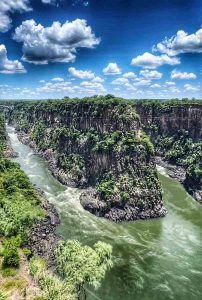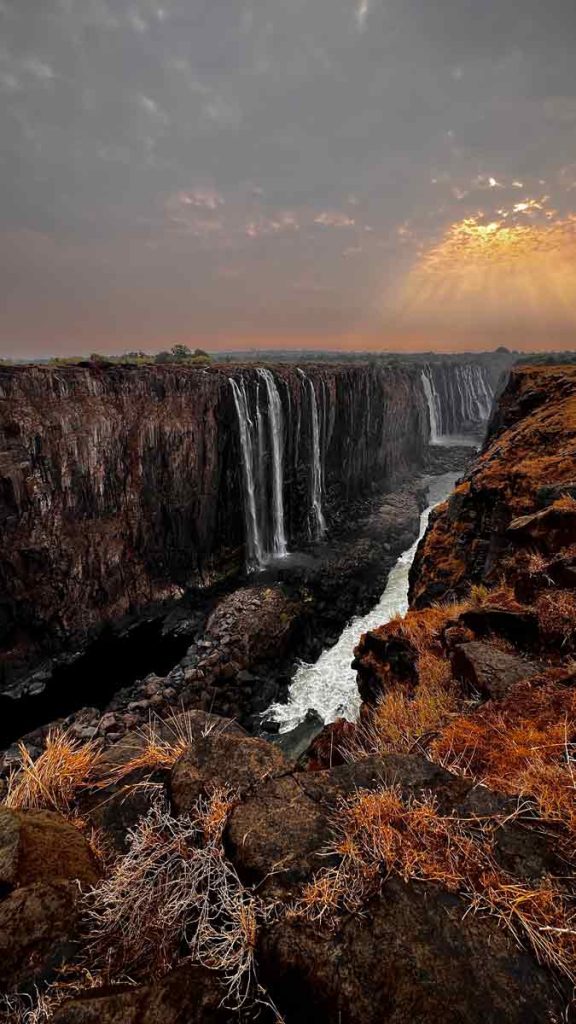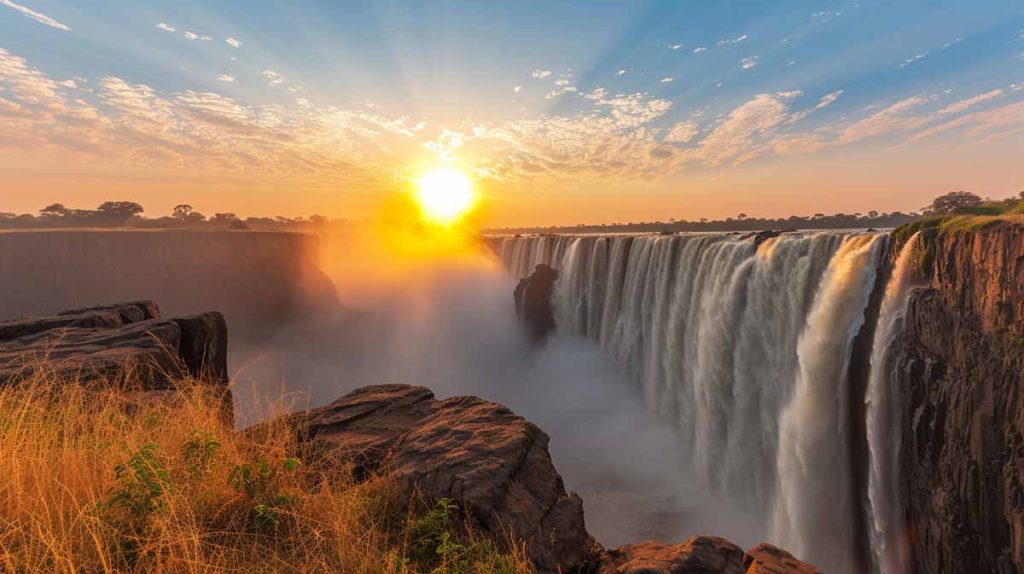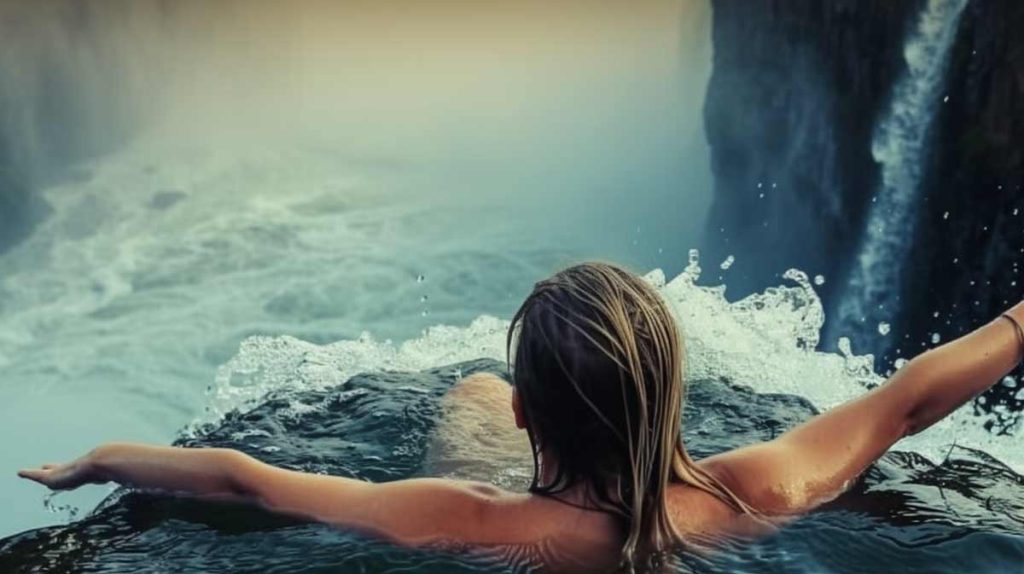Victoria Falls is one of the world’s largest and most breathtaking waterfalls, and is a paradise for photographers. The Falls’ sheer magnitude and natural beauty provide countless opportunities for capturing stunning images. Whether you are an amateur or a professional photographer, visiting Victoria Falls is a golden opportunity to catch some of the most iconic shots of your career. Read on if you want to capture those shots that are a little more unique than the standard Devil’s Cataract shot from a viewpoint.
Discover Victoria Falls and everything that it has to offer.
Photographing Victoria Falls
Best Time of Day for Photography
The best time to capture Victoria Falls photos is early morning or late afternoon when the light is soft and golden. The sun’s angle during these times provides a warm glow, enhancing the Falls’ natural beauty and creating stunning photographic opportunities.
Recommended Equipment for Capturing Victoria Falls Photos
When photographing Victoria Falls, it’s no longer essential to have a quality DSLR camera with a wide-angle lens, but even a good smartphone camera is able to capture the expansive view of the Falls. A sturdy tripod will always help for stabilising your camera and capturing long exposure shots of the cascading water, but we’re going to concentrate here in finding the shot for a unique lasting memory.
Tips for Achieving Unique Angles
Explore different vantage points and angles to achieve unique and compelling photographs of Victoria Falls. Venture to the edges of the Falls or find elevated viewpoints to capture the Falls from a different perspective, showcasing the grandeur and power of this natural wonder.
1. Victoria Falls Bridge: A Photographer’s Perspective
- Location: Connecting Zimbabwe and Zambia.
- Composition: Capture the bridge with the Falls in the background.
- Best Time: Early morning or late afternoon for softer light.
- Tip: Experiment with long exposures for a smooth water effect.

Capturing the Bridge Against the Backdrop of the Falls
The Victoria Falls Bridge offers a breathtaking backdrop for photography. With the Falls in the distance spanning the majestic Zambezi River, position the yourself to frame the bridge against the backdrop of the Falls for a striking composition that highlights the engineering marvel against the natural wonder.
Photographing the Bridge at Different Times of Day
Experiment with capturing the Victoria Falls Bridge at various times of the day to take advantage of the changing light and atmospheric conditions. Whether bathed in the warm glow of sunrise or silhouetted against the vibrant hues of sunset, each moment presents a unique opportunity to create stunning images.
Using the Bridge to Frame Shots of the Falls
You can use the bridge as a framing element in your photographs, drawing attention to the captivating vista of the Falls beyond. By incorporating the bridge into your shots, you can create visually dynamic compositions that showcase the interplay between artificial structure and natural beauty.
2. Capturing the Rainbow at Victoria Falls
- Location: From either the Zimbabwe or Zambia side, the rainbow can be captured from either below or above
- Composition: Try to capture the rainbow against the white spray of the Main Falls.
- Best Time: Early morning or late afternoon for softer light. Consider the sun’s position at different times of day to aid in composition.
- Tip: Using a polarising filter will reduce glare and saturate the colours.
Optimal Conditions for Photographing the Rainbow
One of the most iconic natural phenomena at Victoria Falls is the rainbow that often graces the misty spray of the Falls. To capture vibrant rainbow shots, visit the Falls during mid-morning or mid-afternoon when the sun’s angle creates optimal conditions for the appearance of colourful rainbows in the mist.
Techniques for Enhancing Rainbow Photography
To enhance the visual impact of rainbow photography, consider using a polarising filter to reduce glare and saturate the colours of the rainbow. Experiment with different exposure settings to achieve the perfect balance of light and shade, resulting in striking and vivid rainbow imagery.
Recommended Camera Settings for Rainbow Shots
To capture the intricate beauty of rainbows at Victoria Falls, set your camera to a low ISO to maintain image clarity and adjust the aperture to balance depth of field and light sensitivity. These settings will enable you to capture the subtle nuances and brilliance of the rainbow in your photographs.
3. Sunset Photography at Victoria Falls
- Location: Capture the sunset from the Zambian or Victoria Falls Bridge. Or use the light to achieve dramatic waterfall effects.
- Composition: Get features such as the Bridge flooded in sunset hues of red and gold.
- Best Time: Sunset!
- Tip: Experiment with Neutral Density filters and graduated filters.

Top Sunset Photography Spots at the Falls
Victoria Falls offers numerous vantage points for capturing breathtaking sunset shots. The Zimbabwean side of the Falls provides stunning panoramic views, while the Zambian side offers unique perspectives for photographing the Falls as the sun dips below the horizon.
Creating Stunning Silhouette Shots during Sunset
Silhouette photography can add a touch of drama and artistry to your images during sunset. Position yourself to silhouette the outline of wildlife, trees, or people against the colourful sky, creating captivating compositions that evoke the serene beauty of the setting sun at Victoria Falls.
Utilising the Colors of the Sky for Dramatic Sunset Photos
Embrace the rich and varied colours of the twilight sky to capture dramatic sunset photos. Experiment with exposure settings to balance the colours of the sky and the surrounding landscape, creating images that convey the magical and fleeting beauty of twilight at Victoria Falls.
4. Exploring the Gorge: The Boiling Pot
- Location: At the base of the Falls, accessed via a steep path.
- Composition: Capture the swirling waters from a lower vantage point.
- Best Time: Mid-morning to avoid harsh shadows.
- Tip: Be prepared for mist and protect your camera and lens dry.

Shooting the Gorge from Different Vantage Points
The Batoka Gorge, carved by the mighty Zambezi River, offers compelling photography opportunities. Explore different vantage points along the gorge to capture the interplay of light and shadow, emphasising the chasm’s rugged terrain and raw power.
Capturing the Play of Light and Shadow in the Gorge
As the sunlight dances across the chasm of Batoka Gorge, it creates ever-changing patterns of light and shadow. Use the dynamic interplay of light to add depth and complexity to your gorge photography, capturing the dramatic contrast between sunlit cliffs and shadowed crevices.
Highlighting the Gorge’s Unique Features in Photography
From its towering cliffs to the churning rapids of the Zambezi River, the Batoka Gorge is replete with unique features ripe for photographic exploration. Pay attention to the gorge’s details, textures, and scale, capturing its grandeur and untamed beauty through your lens.
5. The Thrill of the Edge: Devil’s Pool
- Location: On the Zambian side of the Falls, at the very edge of the waterfall.
- Composition: Aim for dramatic angles to showcase the pool’s precarious position at the waterfall’s edge.
- Best Time: During the dry season, typically from September to December, when the pool is accessible.
- Tip: Use a wide-angle lens to capture the pool and the vast Falls drop.
- Experiencing the Edge at Devil’s Pool

Devil’s Pool is an enthralling photography spot at the top of the Falls, offering a unique blend of danger and beauty. Perched on the edge of Victoria Falls, this natural pool provides an unparalleled view of the cascading waters. Photographers can capture the sheer scale of the Falls and the daring of those swimming at the edge. This is one of the most Instagram-able spots, requiring a sense of adventure and daring to get there with your equipment if you’re brave enough.
Capturing the Drama of Devil’s Pool
The juxtaposition of calm waters in the pool against the ferocious waterfall nearby creates a dramatic scene. Photographers should focus on capturing this contrast, emphasising the thrill and beauty of the pool. Early morning light can add a mystical quality to the scene, enhancing the natural colours and softening the harsh edges of the Falls.
Highlighting the Unique Perspective of Devil’s Pool
Devil’s Pool offers an unmatched perspective of Victoria Falls. From this vantage point, photographers can capture the grandeur of the Falls, the depth of the drop, and the bravado of those daring to swim at the edge. Close-up shots of the water’s edge and wide shots that include the horizon can both tell powerful stories of this unique spot.
6. Soaring Heights: Helicopter Ride Over Victoria Falls
- Location: Above Victoria Falls, providing an aerial perspective.
- Composition: Focus on capturing the vastness of the Falls and the surrounding landscape.
- Best Time: Early morning or afternoon for optimal lighting and minimal mist.
- Tip: Use a high shutter speed to counteract the helicopter’s movement and reduce blurriness.
Capturing the Majesty from Above
A helicopter ride over Victoria Falls offers photographers an unmatched vantage point. From this aerial perspective, the Falls can be captured in a single frame, showcasing their immense scale. The bird’ s-eye view allows for breathtaking compositions, including the winding Zambezi River and the surrounding rainforest.
Embracing the Aerial Perspective
Photography from a helicopter presents a unique opportunity to capture the interplay of light and shadow across the landscape. The sun’s changing angles can cast dramatic shadows and highlight the contours of the water and land. Photographers should be prepared to adjust settings quickly to adapt to varying lighting conditions.
Highlighting the Contrast of Natural Elements
From the air, the stark contrast between the thunderous Falls and the calm stretches of the Zambezi River is striking. Capturing this contrast can convey the power and beauty of the natural world. Wide-angle lenses are ideal for these shots, allowing for a broad capture of the Falls, river, and surrounding environment.
7. Enchanted Walk: The Rainforest Path
- Location: Along the rainforest on the edge of Victoria Falls.
- Composition: Use the natural lines of the path and lush greenery to lead the eye.
- Best Time: Early morning for soft light and fewer visitors.
- Tip: Bring a polarising filter to enhance the rich greens and manage reflections on wet foliage.

Immersing in the Lush Rainforest Path
The Rainforest Path at Victoria Falls offers a serene contrast to the grandeur of the Falls. This tranquil trail, shrouded in mist and surrounded by dense, vibrant foliage, provides photographers with myriad compositions. Capture the play of light filtering through the canopy, highlighting the diverse flora and creating a mystical atmosphere.
Capturing the Intimacy of the Rainforest
The path winds intimately through the rainforest, allowing for close-up shots of unique plants, flowers, and occasional wildlife. Photographers should focus on the details that make this path unique, such as dewdrops on leaves, the texture of the bark, and the interplay of light and shadow. The calm and quiet of the rainforest also allows for thoughtful, contemplative photography.
Highlighting the Rainforest’s Unique Ecosystem
This path isn’t just a walk through the woods; it’s an immersive experience in a unique ecosystem. In your photography, emphasise the lushness and diversity of the rainforest. Capturing the varying shades of green and the vegetation’s density conveys this environment’s richness. Wide shots showing the trees’ scale alongside the path can also be striking.
8. Urban Wilderness: Capturing Wildlife on the Streets of Vic Falls Town
- Location: Throughout the streets and public areas of Victoria Falls Town.
- Composition: Focus on the interaction between wildlife and urban elements.
- Best Time: Wildlife is more active in the early morning or late afternoon.
- Tip: Use a telephoto lens to capture close-up shots safely without disturbing the animals.
Exploring the Urban-Wildlife Interface
Victoria Falls Town presents a unique blend of urban life and wild nature, where wildlife freely roams the streets. This setting allows photographers to capture the unusual sight of animals in an urban backdrop. The contrast between the natural and the man-made, such as animals wandering past shops or resting in town squares, makes for compelling imagery.
Capturing the Candid Moments of Wildlife in Town
Photographing wildlife in this urban setting requires patience and readiness to capture spontaneous moments. The key is observing and waiting for those natural interactions, whether a warthog crossing the road or monkeys playing in a park. If you are lucky, witnessing an elephant standing outside the souvenir shop or grazing someone’s hedge at home is not unusual! The aim is to depict the harmony (or sometimes the contrast) between the town’s daily life and its wild, untamed visitors.
Highlighting the Coexistence in Vic Falls Town
The coexistence of humans and wildlife in Vic Falls Town provides a narrative about adaptation and shared spaces. Focus on shots that tell a story about this coexistence. Look for moments that showcase the adaptability of wildlife, such as birds nesting on buildings or antelopes grazing on lawns. Wide-angle shots encompassing the urban environment and the animals can be particularly impactful.
9. Lunar Spectacle: The Moonbow at Full Moon over the Falls
- Location: The best views are from viewpoints along the Falls where the mist is heaviest.
- Composition: Capture the vastness of the Falls with the moonbow arcing across.
- Best Time: The moonbow is most visible on clear nights during a full moon.
- Tip: Use a tripod and a long exposure to capture the moonbow’s colours against the night sky.

Witnessing the Moonbow’s Magic
The phenomenon of the moonbow at Victoria Falls is a breathtaking sight, unique to only a few places in the world. This lunar rainbow occurs during a full moon; this lunar rainbow is created by the moon’s light reflecting off the mist generated by the Falls. Capturing this ethereal, nocturnal rainbow requires patience and a clear night sky. Photographers should aim to convey the surreal and magical quality of the moonbow set against the backdrop of the mighty Falls.
Capturing the Moonbow’s Ethereal Beauty
To photograph the moonbow, it’s essential to balance the low-light conditions. Long exposures are crucial to capturing the moonbow’s subtle colours and dynamic flow. Experimenting with different shutter speeds can yield varying effects on the water’s appearance, from silky smooth to crisply captured motion. Including the surrounding landscape can add context and scale to the moonbow’s delicate arch.
Highlighting the Contrast Between Night and Light
The moonbow offers a rare opportunity to capture the interplay of natural light and darkness. The contrast between the night sky, the illuminated mist, and the moonbow makes for a dramatic and compelling photograph. Wide-angle lenses can help capture the breadth of the Falls and the entire arc of the moonbow, while telephoto lenses can be used for more focused, detailed shots of the rainbow and the Falls.
10. Historic Discovery: Livingstone Island
- Location: At the edge of Victoria Falls, accessible from the Zambian side.
- Composition: Frame the Falls as a backdrop to the island, highlighting its proximity to the edge.
- Best Time: During the low water season, usually from September to December, for safer access and clearer views.
- Tip: Use a polarising filter to reduce glare from the water and enhance the natural colours.
Capturing the Essence of Livingstone Island
Livingstone Island, named after the explorer David Livingstone, holds a special place in the history of Victoria Falls. This small, serene island at the edge of the Falls offers a unique vantage point. Photographers can capture the tranquil island’s juxtaposition against the Falls’ thunderous backdrop. This is an opportunity to explore landscape and historical narrative in your photography.
Embracing the Island’s Intimate Perspective
Photography on Livingstone Island is about capturing intimacy amidst grandeur. The island provides close-up views of the cascading waters, allowing for detailed shots of the Falls’ edge and the mist rising from the gorge. Wide-angle lenses are ideal for capturing the expansive panorama of the Falls. In contrast, macro lenses can be used to focus on the smaller, often overlooked details of the island’s natural beauty.
Highlighting the Island’s Unique Position
Livingstone Island’s unique position at the brink of one of the world’s largest waterFalls allows for dramatic and powerful imagery. Photographers should focus on contrasting the island’s calm and the Falls’ raw power. Early morning or late afternoon light provides softer lighting conditions, ideal for capturing the textures and layers of the landscape.
Related Victoria Falls Posts
Discover family-friendly activities at Victoria Falls, a stunning UNESCO World Heritage Site, perfect for adventure and wildlife enthusiasts in 2024
Victoria Falls, located on the border of Zambia and Zimbabwe, is one of Africa’s most breathtaking natural wonders. It is the largest waterfall in the world in terms of combined width and height, making it a must-visit tourism destination. Victoria…
Explore the Enchanting Beauty of Victoria Falls Rainforest in 2024
The Victoria Falls Rainforest is a mesmerizing destination that allows visitors to witness the natural wonder of Victoria Falls. As one of the world’s most renowned waterfalls, the site is a must-see for any nature enthusiast. In 2024, this enchanting…
Devil’s Pool at Victoria Falls, Livingstone Island in Zambia
Amidst the sheer grandeur of Victoria Falls on the Zambian banks lies an enthralling attraction – the Devil’s Pool. This beguiling natural wonder of Africa, famously known as Mosi-oa-Tunya, offers a refreshing swim on the brink of the majestic falls…
Unveiling the Enchanting Beauty of Moonbows: A Guide to Lunar Rainbows
As an avid traveller and explorer, I’ve been fortunate enough to witness some of the most awe-inspiring natural phenomena globally. Among these, the elusive and enchanting moonbow, or lunar rainbow, has always held a special place in my heart. In…
The Mighty Zambezi River: Facts, Features, and More
Zambezi River The Zambezi River, the fourth-longest river in Africa, is a stretch of the river that holds immense significance due to its diverse features and vital role in the ecosystem. Zambezi River Landscape Zambezi River Facts The Zambezi River,…
